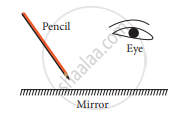Advertisements
Advertisements
प्रश्न
Name the mirror which forms an erect, virtual and enlarged image of an object. What is the position of object relative to the mirror?
उत्तर
The concave mirror can form an erect, virtual, and enlarged image of an object when the object is placed between the mirror and its focal point (F).
Explanation:
- When the object is positioned closer to the mirror than its focal point, the reflected rays appear to diverge, and the image forms behind the mirror.
- The image is:
- Erect (upright),
- Virtual (cannot be projected on a screen),
- Enlarged (magnified).
Example:
This principle is often used in makeup mirrors and shaving mirrors to provide a magnified view of the face.
APPEARS IN
संबंधित प्रश्न
Rays of light incident parallel to the principal axis pass through the focus after reflection from a concave mirror.
What is a real image? Name the mirror which can be used to obtain the real image of an object. What should be the position of the object relative to the mirror?
Classify as real or virtual, the image of a candle flame formed on a screen by a convex lens. Draw a ray diagram to illustrate how the image is formed.
Say TRUE or FALSE
The image formed by the plane mirror is laterally inverted, hence the image seen through the periscope is also laterally inverted
Say TRUE or FALSE
The image formed in a pinhole camera is always inverted
Say TRUE or FALSE
The image formed in a plane mirror is upside down
Figure shows a pencil placed above a mirror

- Draw its image formed by the mirror
- Show how light rays from the object are reflected at the mirror to form the image for the eye.
We can create enlarged, virtual images with ______.
Match the following:
| 1. | Real image | a. | Diffuse reflection |
| 2. | Virtual image | b. | An optical device which produces reflection |
| 3. | Mirror | c. | Cannot be taken on screen |
| 4. | A type of light scattering | d. | Can be taken on screen |
An object is placed at a distance of 3cm from a plane mirror. The distance between the object and image is 3cm.
